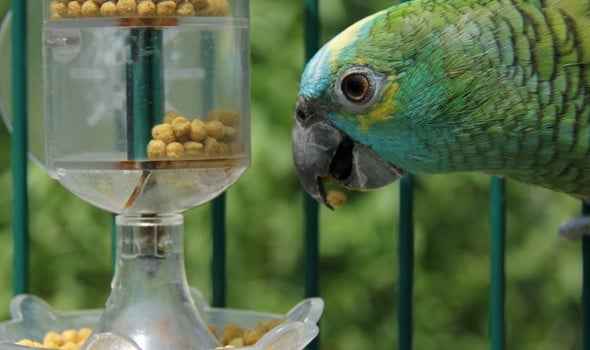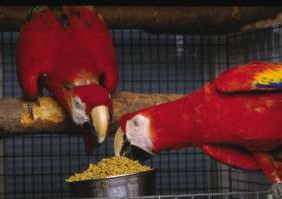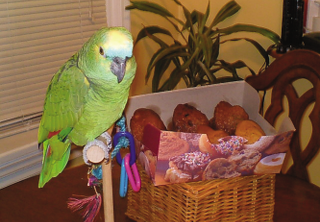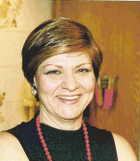
Converting Diet to Pellet Food For Birds
Twelve Steps to Success
Mother Nature has had millennia of experience in diet formulation, and the birds in their various natural habitats have evolved to fit the diets available to them in the wild. In the wild seasons change, availability changes, and one generation teaches the next what to eat. In captivity our birds are entirely dependent on what we supply them with, which usually has absolutely no resemblance to what they have evolved to eat. Consequently, birds on seed diets tend to choose the seeds they enjoy most and eat those in excess. Even if your bird ate all the seeds in the seed mix, an all seed diet has long been recognized as being woefully inadequate in supplying pet birds with a complete complement of essential nutrients, as all seed diets are known to be deficient in calcium, available phosphorus, sodium, manganese, zinc, iron, iodine, selenium, vitamins A,D,E,K, riboflavin, pantothenic acid, niacin, B2, and choline. Birds on all seed diets have invariably been shown to have excess body fat and deficient calcium reserves.
In fact, most domestically raised larger psittacines are raised on pelleted rations, and many of the nutritionally related problems, which were always common in these species, are slowly becoming a thing of the past. 
The recognition of this fact has led to the development of complete diets in the form of pellets, which are slowly replacing seeds as the staple diet of most pet birds.
Nonetheless, there are still some birds that have been conditioned to eat “seed only” diets and it is in these birds that nutritional health problems are still common. Remember, it is our role as “Parrot Parents” to teach our birds what is safe and healthy to eat, and just as we would never allow our children to eat nothing but chocolate bars because “that’s all he likes”, we have the responsibility to make healthy diet choices for our pets. This article should help you convert your bird to a healthier diet and thereby improve your bird’s general health and longevity.
Introducing the New Diet
Birds that have been eating seed diets for years sometimes resist the introduction of pellets. This is particularly true for budgerigars and cockatiels. Nonetheless, the importance of a good diet cannot be overemphasized, so persistence and patience are essential. Understanding your bird’s natural instincts as they relate to food gathering and flock behavior can increase your likelihood of success.
Since birds are often suspicious of anything new, the transition from seeds to pellets must be done gradually. Starving a bird into eating pellets by suddenly removing his usual seed mixture is not advisable. Pellets must be introduced to a bird’s diet in such a way as to allow the bird to become accustomed to the sight and taste of the pellets before totally removing the seed diet.
Encouraging acceptance of new foods begins by understanding a bird’s natural behaviour. In the wild, food gathering is one of the most important tasks a bird engages in. Because of its high metabolic rate, a bird can starve within two to three days without adequate caloric intake. Consequently food gathering takes up a large part of a bird’s day, and finding new food sources is a continuous intellectual challenge, and source of stimulation for the bird. In captivity, our habit of providing the same food source in the same location continually day after day does not provide suitable motivation, nor does simply placing a new food in the cage provide the motivation the bird requires to eat it. Motivation can only be stimulated by renewing the bird’s interest in food as a source of pleasure.

In the wild, most food gathering activity takes place at dusk and dawn. Thus, the first thing one needs to do is establish a twice-daily feeding schedule. A bird can fill its crop in 15 to 60 minutes, and this quantity of food will last 8-12 hours, so you need not worry about the bird starving during the day. However, common sense dictates that food must be provided twice daily on a consistent basis, and not forgotten, missing a feeding altogether. It is also true that very small birds such as finches and canaries cannot go this long between feedings, and a minimum of three meals a day is required. It is also useful to determine the amount of food your bird eats on a given day. If you weigh your dish after filling, and again before covering your bird for the night, every night over the course of 2 weeks, it will give you an idea of what your bird actually consumes. This can be important for the gradual conversion method, as many people have a tendency to overfill their bird’s dishes. Even when they are offereding a pellet/seed mix, the bird continues to eat only the seed, having been offered enough seed in the full dish to subsist on.
Twice daily feeding has several important psychological benefits. It increases hunger, thereby reawakening the desire for food that has been previously blunted by ready availability. It increases bonding between you and your pet, because the pet begins to recognize you as the food source. It prevents boredom by creating a mental state of anticipation. It also has the psychological benefit of allowing the bird to eat in a “flock” if you make a point of eating your own meals at the same time in the presence of the bird, because birds are flock feeders. You may have noticed with your own birds that they have the tendency to go to the food dish when you eat in their presence. We’ll examine how you can take advantage of this instinct in the next section.
Once this pattern has been established, many methods of new food introduction can be tried. It is important to remember that the birds are always suspicious of anything new, so that new foods must be presented consistently several days or weeks in a row before you can even hope to have them noticed. Birds also have changes in taste as we do; they can become bored with certain foods, and go off them for a while, only to enjoy them again several weeks or months later.
Methods of New Food Introduction
Before getting started, it is important to have your pet checked out by your veterinarian to determine that your bird is healthy enough to undergo diet conversion. Birds that have had surgery or are convalescing from an illness should not undergo a diet switch unless advised by your veterinarian
IMPORTANT When converting pellets, it is essential to monitor your bird’s weight or it’s droppings.
Gradual Conversion Method
This is the method people are most familiar with, but has limited success because people are often looking for quick fixes. It involves mixing the pellets and seeds together in a 10% pellet/90% seed ratio for approximately 2 weeks. After this time, the ratio of pellets can be increased to 25%, 50%, 75%, and 100%, with 2 – 3 week intervals between each stage. This method is most successful if the bird is fed a specific daily allotment of food based on their normal dietary intake, as listed above. Owners should be aware that, with this method, the bird often has setbacks where they stop eating or stall at a specific stage. This is where most owners give up. It is important to stick with it and take baby steps both forward and back as indicated by your individual bird. This is by no means the only conversion technique available, but using it in conjunction with one or several of the techniques listed below will exponentially increase your chances of success.
Several Successful Methods of Converting to Pellets
Step 1
After the regular morning meal, during the day put some of the new food (pellets) in the food bowl, not the regular diet. If the bird gets hungry during the day, it may venture to try it.
Step 2
Place a thin layer of the new food over the top of the regular diet so the bird has to pick through it to get to the known food. Make sure to sprinkle the new food over the top in front of the bird, so that the bird knows that there is something it considers edible underneath, or the bird may refuse to touch the food altogether.
Step 3
Alternatively, cover the pellets with a thin layer of the regular diet. The bird will often eat through the top layer into the new food. Parrots in quarantine stations have been converted to pellets within a week by overlaying pellets with canned corn, fruit cocktail, or another food that they were used to consuming. If you are using any moist foods in your conversion efforts, remember that moist foods can grow bacteria quickly, and must be removed from your birds cage after 2-3 hours to prevent any spoilage that could make your bird ill.

Step 4
In the wild, birds have a tendency to eat primarily during morning and evening, just like we do. You can take advantage of that by having your bird present when you eat breakfast/dinner, either on a play stand, or in their cage. Eating is a flock behavior in the wild. If one bird in the flock starts eating, the others will join in. If your bird sees you eating, it will be stimulated to eat too. If you take your birds food away 1 hour prior to dinner, its appetite will be piqued. While you eat, offer the pellets you have been using in their regular food dish. When your bird sees you eat, it will go over to its dish and investigate. It may take a few tries, but eventually it will start to sample the new food. After dinner, you can return the bird to its normal spot and give it a dish of seeds mixed with pellets. This is a highly successful technique because your bird is rewarded by increased time and interaction with their favorite people.
Step 5
Knowing a little about the way your bird feeds in the wild can help you devise your own techniques as well. If your bird is a grassland bird (budgies, cockatiels, parakeets, cockatoos, etc…) they may be more inclined to eat off the ground. Place a mirror on the bottom of the cage floor and place several large stones on it. The stones should be too big for the bird too swallow, but small enough that the bird can turn around and move them. Natural aquarium gravel, available in different sizes (new, not used) can be good for this purpose. Mix a small amount of seeds in with the gravel. This will encourage natural foraging behavior in your bird. After your bird is foraging, you can begin to mix pellets in as well. This can be continued after your bird has switched their diet to allow your bird mental stimulation as they work for their food, just like it would in the wild.
Step 6
If the bird is particularly people oriented, sometimes the best trick is to eat the new food in front of it. Make loud noises of approval, widen your eyes in an effort to imitate the bird’s ability to dilate its pupils when excited, and make every effort to imply how wonderful the new treat is. If the bird comes over to investigate, refuse to share at first, increasing the birds jealousy and desire to try it. Remember that directly “mouth feeding” your bird is not advisable as our mouths contain bacteria which can cause gastrointestinal illness in birds.

Step 7
Some birds will accept pellets more readily if they are first converted to a soft food diet (soaked pellets, rice, corn, mixed beans, mixed frozen veggies), and then to pellets.
Step 8
The presence of other birds seems to be a real force in helping birds to convert to pellets. Competition for food, tendency to mimic, and group pressure prompts birds to eat new foods quickly. One bird’s behavior depends in part on how the other birds behave. It is not surprising that groups of birds in a flight cage will begin eating pellets readily. If you have more then one bird in separate cages, and one is already a pellet eater, you can move the cages side-by-side during meal times, encouraging the seed eater to mimic the pellet eater.
Step 9
A good method for smaller birds is to make “pellet pancakes”, particularly if the bird is willing to eat bread or toast. Use pellet crumbles, and add enough water to moisten. Add the white of an egg, but only half the yolk (to avoid giving the bird too much cholesterol). Add just enough water and mix so that the mixture resembles pancake batter. Fry the mixture in a frying pan with a little vegetable oil. The mixture can now be broken into small squares and frozen in individual servings to keep it fresh. Thaw completely before serving, and crumble to an appropriate size for your bird. Combining this tip with tip #5 is often successful. You may also find many “bird friendly” bread/muffin recipes in magazines, books, or on the internet which use pellets and healthy vegetables as primary ingredients.
Step 10
If your bird is fond of other types of food, you can use those to introduce the new food. If your bird likes fruit, stick pellets into the pieces of cut fruit. If your bird likes bread, work pellets into the surface of the bread. If your bird likes spray millet, stick pellets between the branches. If your bird likes honey sticks, use one that has pellets added, or make your own using corn syrup, a small amount of seed, and pellets.
Step 11
Some birds are attracted by different things. Some birds will love brightly coloured pellets, others will prefer pellets the same colour as the seeds they are use to eating. Some birds like fancy shapes, others plain kibble. The important point is to keep trying until you find a pellet your bird will accept. Once you pattern your bird to accept new foods, you will find it easier to switch to a pellet of your choice. Consult your avian veterinarian for recommendations on appropriate diets.
A normal bird produces 8 – 24 droppings in a 24-hour period. Purchase a small kitchen or postal scale, and outfit it with a perch (for lager birds) or a bucket (for smaller birds) to check your birds weight on a weekly basis. If the number of droppings decreases by 25%, becomes skinny and very dark, or if your bird drops more than 10% of its body weight, return to seeds and start again with lower portions of pellets, then increase the amount again gradually once your bird has returned to normal.
Step 12
Never underestimate the effects of positive reinforcement. Watch your bird, and if you see them take a pellet into their beaks, or investigate a dish only containing pellets, tell them what a fabulous, smart and special birdie they really are.
Once on a pelleted diet, you will notice that your birds’ droppings change from green to brown. Also, due to a higher water intake the droppings will be a little wetter and bulkier. This is normal and no cause for concern. However, should the droppings become very wet, or change colour to dark green or black, this may indicate illness or lack of proper nutrition. Have your bird seen by your veterinarian. Be aware of what you’re feeding. If you are feeding a coloured pellet to your bird, that colour may come out in the droppings. Also be aware of normal variations in the stools your bird produces throughout the day.
The ideal diet for most birds is a diet consisting of 85% fresh pellets, 10% fresh dark leafy green or yellow vegetables, and at most 5% fruit. This must be the proportions they are actually eating, and not just the proportions offered. Birds eat to meet their energy requirements. If too much fruit is offered, the bird’s energy requirements will have been met, but not the birds’ nutritional requirements. Seeds are an important, if somewhat small portion, of a healthy diet for grassland birds (budgies, cockatiels, parakeets). These species should undergo the same pellet conversion techniques as above, and only have a small (5%) amount of seed added back into their diet when they are eating pellets consistently.
Converting to Pellets
Always remember, the keys to any work we do with our feathered friends: Consistency and perseverance. Some birds may fight any attempt you do to switch them on to healthy diet, just as any child would. You may have to try every technique listed here, and try every pellet brand out there. In the end, your efforts will result in a healthier bird with the potential to live to its full life span. It may take more than a year, but it will be well worth it.
Text & Photography by: Dr. Petra M. Burgmann and Kristi Flemming
Dr. Petra Burgmann, BSc, DVM, Dip. ABVP (Avian Practice) Animal Hospital of High Park, 3194 Dundas St West, Toronto, Ontario, M6P 2A3
Biography Dr. Petra M. Burgmann
Dr. Burgmann received her Bachelor of Science (1980) and Doctor of Veterinary Medicine (1984) degrees from the University of Guelph, and has been practicing exotic pet medicine ever since. She opened her own exotics practice, the Animal Hospital of High Park, in 1986. In 1993 she was the first Canadian to be Board certified by the American Board of Veterinary Practitioners in Avian Practice, and she recertified for an additional 11 years in this specialty in 2002.
Dr. Burgmann is the author of “Feeding Your Pet Bird” as well as a contributing author, in avian and exotic pet medicine, to numerous other texts, journals and publications. She has lectured in exotic pet medicine at the University of Guelph, Seneca College, Toronto Academy of  Veterinary Medicine, Ontario Association of Veterinary Technicians, Pet Industry Joint Advisory Council, Canadian Parrot Symposium, and many other special interest groups. She has also appeared on Cable 10 Community Broadcasting, CFRB, CBC radio, and CBC television.
Veterinary Medicine, Ontario Association of Veterinary Technicians, Pet Industry Joint Advisory Council, Canadian Parrot Symposium, and many other special interest groups. She has also appeared on Cable 10 Community Broadcasting, CFRB, CBC radio, and CBC television.
For a complete discussion of pet bird nutrition, other tips and tricks and other recipes, the best resource is Dr.Burgmann’s book, “Feeding Your Pet Bird”. It is available at the Animal Hospital of High Park (3194 Dundas St. W., Toronto, ON, M6P 2A3), can be ordered through any bookstore , or go online at Amazon.com.
©Care sheet developed by Dr. P. Burgmann & Kristi Flemming for Avian & Exotic Pet Care Inc; copyright 2005



